
House of Stone
The Step Pyramid
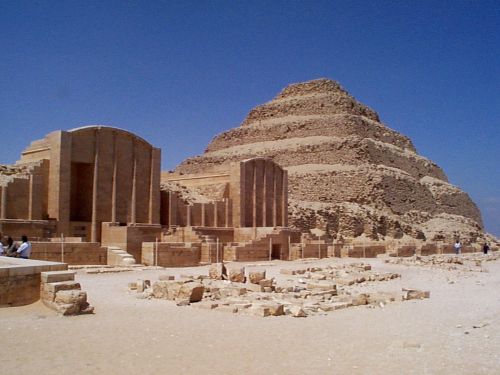

House of Stone
The Step Pyramid

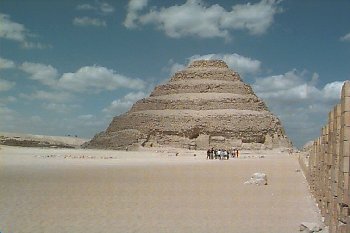
As you enter the pyramid complex you approach the south side of the pyramid across a great courtyard. This courtyard used to serve as a running field for the King's Sed Festival during which the king would demonstrate to the people his continuing physical prowess and ability.
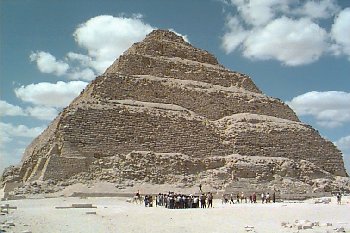
As you round the right side of the pyramid you face its east side. In later pyramids this side would contain the Mortuary temple. In this prototype pyramid complex there is no Mortuary temple.
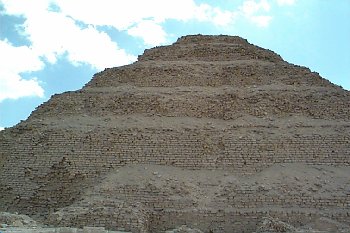 |
The north side
contains the opening of the pyramid. Throughout the pyramid age, most pyramids would
continue this pattern of an opening on the north side.
|
|
|
|
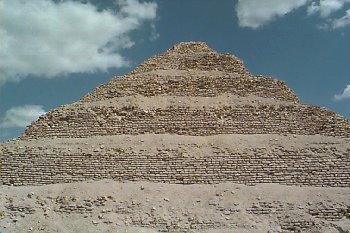
Here is the pyramid as it appears from the west side.
Djoser
Step Pyramid
Original height: approx: 204 feet
Base: 411’ x 358’
built in accretions that lean inward
used bigger blocks – no mortar of tafla
It is presently accepted that the Step Pyramid of Djoser (AKA Netjerykhet) represents the initial transition from mastaba to pyramid. Indeed, this pyramid actually started out as a mastaba, and was expanded in a series of stages that result in its present appearance which is a pyramid consisting of 6 distinct steps. One of the things that are unique about the Step Pyramid is the arrangement of its internal passageways and chambers. This pyramid has the most complex underground layout, and was one of the very first of its kind. The main excavator that has done the most work on this pyramid and its surrounding structures is Jean-Philippe Lauer.
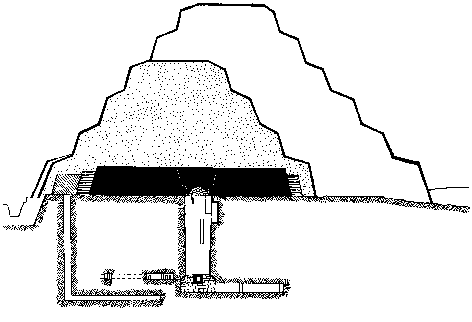
The building of the pyramid was undertaken in several stages. The initial interior consisted of a shaft, 7m square which descended for 28 meters. This terminates in a chamber which is the burial chamber. This chamber was built of granite blocks. The entrance to the burial chamber is a circular opening at the top of the chamber that led to another room which has since been destroyed. The hole into the chamber was plugged with a granite piece which is 2 m high.
There is a 20 meter tunnel leading northward that would have extended to outside the tomb during its initial stage as a mastaba. When the tomb was ended by steps to a pyramid this caused the tunnel to now end blindly.
The burial chamber was surrounded by four galleries which were cut around the burial chamber and probably contained the funerary equipment of the king. Some of the galleries were lined with blue faience tiles, and resembled mats which were hung on the walls of the kings royal residence.
Additionally, there were shafts cut into the eastern side that were over 32 meters deep. These terminate in a corridor 30 meters long pointed westward toward the original mastaba. All were found during excavations to be looted with the exception of one that contained two alabaster coffins, one of which contained the mummy of a child.
The stages began with the original mastaba. It is believed that the first enlargement consisted of the addition of 3 meters to all sides of the mastaba. The next enlargement added about 9 meters to the eastern side. After this there was again a 3 meter enlargement on all sides. From this base, they began to create 3 more mastabas, stacked up, each smaller than the one below it. This created the first Step Pyramid. A temple was started on the north side. Before this was finished, or perhaps before the pyramid was cased, another revision was made. The pyramid was enlarged on its north and west sides and two additional steps were added. After this it appears that all sides were enlarged once more for the last time yielded the final dimensions of this great monument. The Pyramid was faced with fine white limestone. In its original condition, it must have been a spectacular sight to behold.
READ MORE ABOUT THE STEP PYRAMID HERE.
STAY TUNED FOR MORE!!
RETURN TO Guardian's Egypt - Main Gate
RETURN TO Guardian's Saqqara - Main Gate
Guardian's CyberJourney To
Egypt
Copyright © 1997-2001 Andrew Bayuk
All Rights Reserved